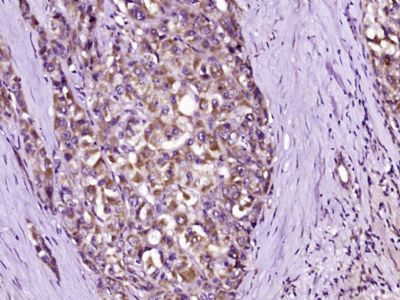产品货号 : mlR6187
英文名称 : C1 Inactivator
中文名称 : 酯酶抑制蛋白C1IN抗体
别 名 : C1 esterase inhibitor; C1 INH; C1 inhibitor; C1-inhibiting factor; C1IN; C1Inh; C1NH; esterase inhibitor; HAE1; IC1_HUMAN; Plasma protease C1 inhibitor; Serine (or cysteine) proteinase inhibitor clade G member 1; Serpin G1; SERPING1.
研究领域 : 心血管 免疫学
抗体来源 : Rabbit
克隆类型 : Polyclonal
交叉反应 : Human, Mouse, Rat, Dog, Pig, Cow, Guinea Pig,
产品应用 : WB=1:500-2000 ELISA=1:500-1000 IHC-P=1:400-800 IHC-F=1:400-800 IF=1:100-500 (石蜡切片需做抗原修复)
not yet tested in other applications.
optimal dilutions/concentrations should be determined by the end user.
分 子 量 : 53kDa
细胞定位 : 分泌型蛋白
性 状 : Lyophilized or Liquid
浓 度 : 1mg/ml
免 疫 原 : KLH conjugated synthetic peptide derived from human SERPING1:401-500/500
亚 型 : IgG
纯化方法 : affinity purified by Protein A
储 存 液 : 0.01M TBS(pH7.4) with 1% BSA, 0.03% Proclin300 and 50% Glycerol.
保存条件 : Store at -20 °C for one year. Avoid repeated freeze/thaw cycles. The lyophilized antibody is stable at room temperature for at least one month and for greater than a year when kept at -20°C. When reconstituted in sterile pH 7.4 0.01M PBS or diluent of antibody the antibody is stable for at least two weeks at 2-4 °C.
PubMed : PubMed
产品介绍background:
C1 Inactivator is a highly glycosylated plasma protein involved in the regulation of the complement cascade. Its protein inhibits activated C1r and C1s of the first complement component and thus regulates complement activation. Deficiency of this protein is associated with hereditary angioneurotic oedema (HANE). Alternative splicing results in multiple transcript variants encoding the same isoform.
Function:
Activation of the C1 complex is under control of the C1-inhibitor. It forms a proteolytically inactive stoichiometric complex with the C1r or C1s proteases. May play a potentially crucial role in regulating important physiological pathways including complement activation, blood coagulation, fibrinolysis and the generation of kinins. Very efficient inhibitor of FXIIa. Inhibits chymotrypsin and kallikrein.
Subunit:
Binds to E.coli stcE which allows localization of SERPING1 to cell membranes thus protecting the bacteria against complement-mediated lysis. Interacts with MASP1.
Subcellular Location:
Secreted.
Post-translational modifications:
Highly glycosylated (49%) with N- and O-glycosylation. O-glycosylated with core 1 or possibly core 8 glycans. N-glycan heterogeneity at Asn-25: Hex5HexNAc4 (minor), dHex1Hex5HexNAc4 (minor), Hex6HexNAc5 (major) and dHex1Hex6HexNAc5 (minor).
Can be proteolytically cleaved by E.coli stcE.
DISEASE:
Defects in SERPING1 are the cause of hereditary angioedema (HAE) [MIM:106100]; also called hereditary angioneurotic edema (HANE). HAE is an autosomal dominant disorder characterized by episodic local subcutaneous edema and submucosal edema involving the upper respiratory and gastrointestinal tracts. HAE due to C1 esterase inhibitor deficiency is comprised of two clinically indistinguishable forms. In HAE type 1, representing 85% of patients, serum levels of C1 esterase inhibitor are less than 35% of normal. In HAE type 2, the levels are normal or elevated, but the protein is non-functional.
Similarity:
Belongs to the serpin family.
SWISS:
P05155
Gene ID:
710
Important Note:
This product as supplied is intended for research use only, not for use in human, therapeutic or diagnostic applications.
产品图片 :












